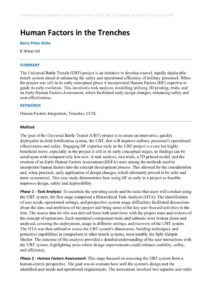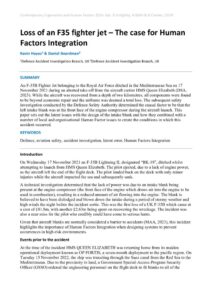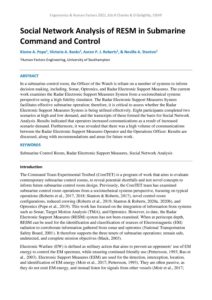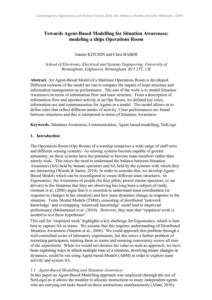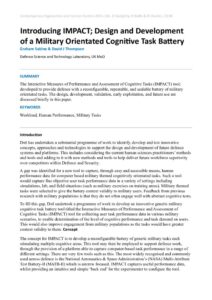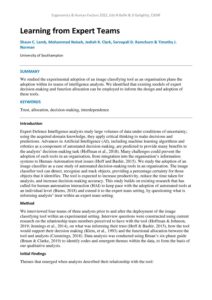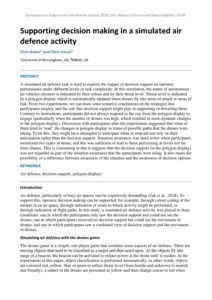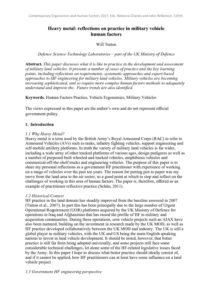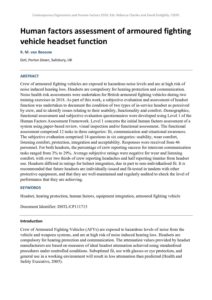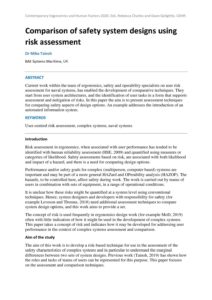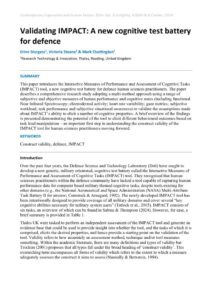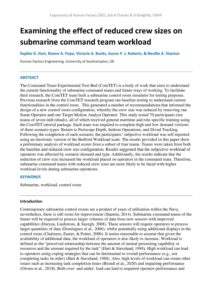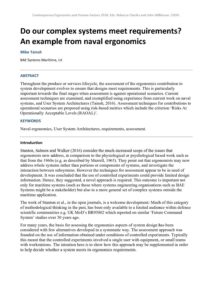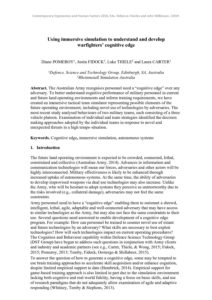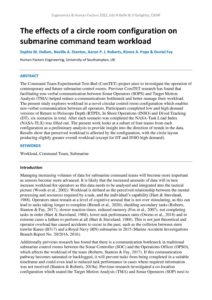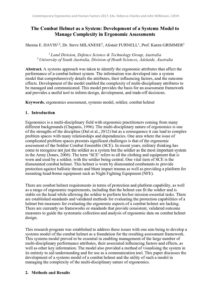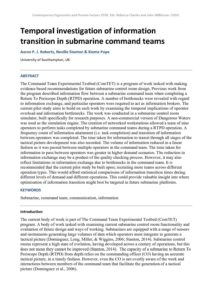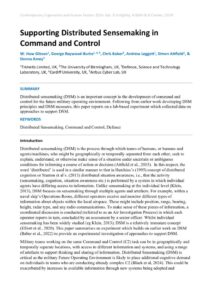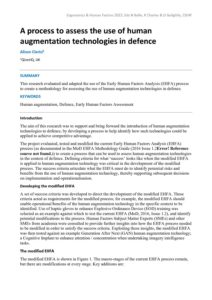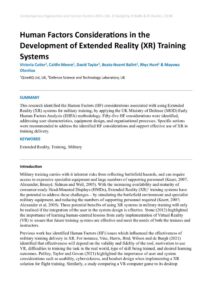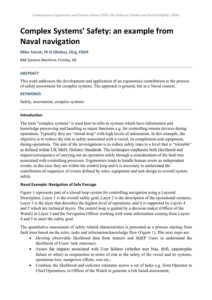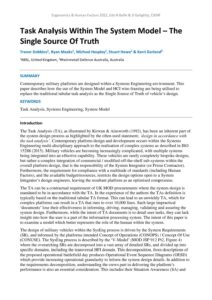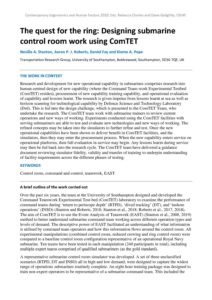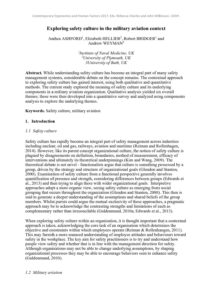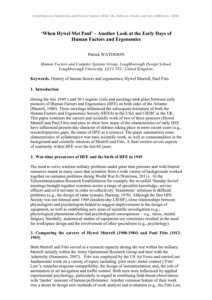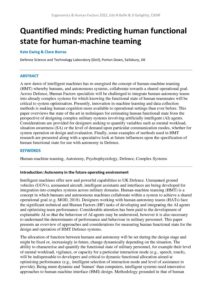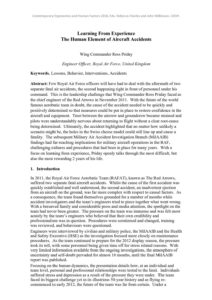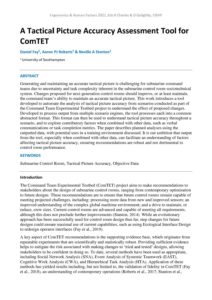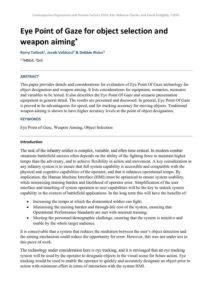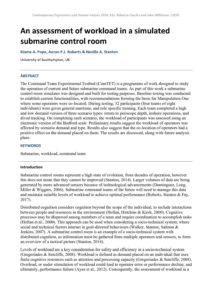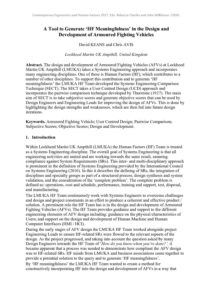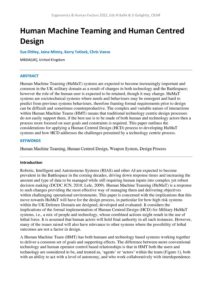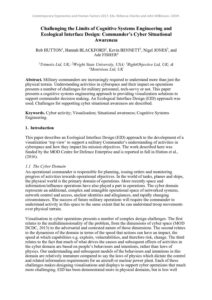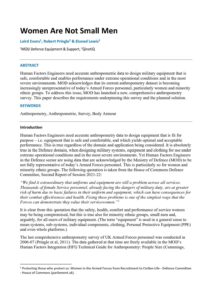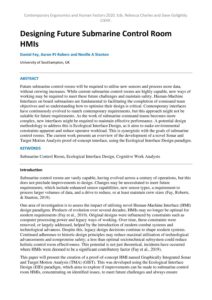Defence
Human Factors in the Trenches
| Document | Author Barry Peter Kirby |
| Abstract The Universal Battle Trench (UBT) project is an initiative to develop a novel, rapidly deployable trench system aimed at enhancing the safety and operational efficiency of military personnel. When the project was still in its early conceptual phase it incorporated Human Factors (HF) expertise to guide its early evolution. This involved a task analysis, modelling utilising 3D printing, trials, and an Early Human Factors Assessment, which facilitated early design changes, enhancing safety and cost-effectiveness. |
Loss of an F35 fighter jet – The case for Human Factors Integration
| Document | Author Kevin Hayes & Daniel Boardman |
| Abstract An F-35B Fighter Jet belonging to the Royal Air Force ditched in the Mediterranean Sea on 17 November 2021 during an aborted take-off from the aircraft carrier HMS Queen Elizabeth (DSA, 2023). While the aircraft was recovered from a depth of two kilometres, all components were found to be beyond economic repair and the airframe was deemed a total loss. The subsequent safety investigation conducted by the Defence Safety Authority determined the causal factor to be that the left intake blank was at the front face of the engine compressor during the aircraft launch. This paper sets out the latent issues with the design of the intake blank and how they combined with a number of local and organisational Human Factor issues to create the conditions in which this accident occurred. |
Social Network Analysis of RESM in Submarine Command and Control
| Document |
|
|
| Abstract In a submarine control room, the Officer of the Watch is reliant on a number of systems to inform decision making, including, Sonar, Optronics, and Radar Electronic Support Measures. The current work examines the Radar Electronic Support Measures System from a sociotechnical systems perspective using a high fidelity simulator. The Radar Electronic Support Measures System facilitates effective submarine operation; therefore, it is critical to assess whether the Radar Electronic Support Measures System is being utilised effectively. Eight participants completed two scenarios at high and low demand, and the transcripts of these formed the basis for Social Network Analysis. Results indicated that operators increased communications as a result of increased scenario demand. Furthermore, it was revealed that there was a high volume of communications between the Radar Electronic Support Measures Operator and the Operations Officer. Results are discussed, along with recommendations and areas for future work. |
Towards Agent-Based Modelling for Situation Awareness: modeling a ships Operations Room
| Document | Author Joanne KITCHIN and Chris BABER |
| Abstract An Agent-Based Model of a Maritime Operations Room is developed. Different versions of the model are run to compare the impact of team structure and information management on performance. The aim of the work is to model Situation Awareness in terms of information flow and team structure. From a description of information flow and operator activity in an Ops Room, we defined key roles, information use and communication for Agents in a model. The model allows us to define rules that reflect different modes of activity. Clear performances are found between structures and this is interpreted in terms of Situation Awareness. |
Introducing IMPACT; Design and Development of a Military Orientated Cognitve Task Battery
| Document | Author Graham Sabine & David J Thompson |
| Abstract The Interactive Measures of Performance and Assessment of Cognitive Tasks (IMPACT) tool; developed to provide defence with a reconfigurable, repeatable, and scalable battery of military orientated tasks. The design, development, validation, early exploitation, and future use are discussed briefly in this paper. |
Learning from Expert Teams
| Document | Author Shaun C. Lamb, Mohammad Naiseh, Jediah R. Clark, Sarvapali D. Ramchurn & Timothy J. Norman |
| Abstract We studied the experimental adoption of an image classifying tool as an organisation plans the adoption within its teams of intelligence analysts. We identified that existing models of expert decision-making and function allocation can be employed to inform the design and adoption of these tools. |
Supporting decision making in a simulated air defence activity
| Document | Author Chris Baber and Chris Vance |
| Abstract A simulated air defence task is used to explore the impact of decision support on operator performance under different levels of task complexity. In this simulation, the status of autonomous air vehicles (drones) is indicated by their colour and by their threat level. Threat level is indicated by a polygon display which is automatically updated when drones fly into areas of attack or areas of risk. From two experiments, we can draw some tentative conclusions on the strategies that participants employ and the role that decision support might play in supporting or thwarting these. Contrary to instructions, participants did not always respond to the cue from the polygon display to engage (particularly when the number of drones was high, which resulted in more dynamic changes to the polygon display). Discussion with participants after the experiments suggested that some of them tried to ‘read’ the changes in polygon display in terms of possible paths that the drones were taking. From this, they might have attempted to anticipate when to respond and rely on their anticipation rather than the decision support. Situation awareness was rated lower when participants monitored two types of drone, and this was sufficient to lead to them performing at levels not far from chance. This is concerning in that it suggests that the decision support (in the polygon display) was not regarded as part of the situation awareness that the participants were using. It also raises the possibility of a difference between awareness of the situation and the awareness of decision options. |
Heavy metal: reflections on practice in military vehicle human factors
| Document | Author Will Tutton |
| Abstract This paper discusses what it is like to practice in the development and assessment of military land vehicles. It presents a number of cases of practice and the key learning points, including reflections on requirements, systematic approaches and expert-based approaches to HF engineering for military land vehicles. Military vehicles are becoming increasing sophisticated, and so require more complex human factors methods to adequately understand and improve the. Future trends are also identified. |
Human factors assessment of armoured fighting vehicle headset function
| Document | Author R. M. van Besouw |
| Abstract Crew of armoured fighting vehicles are exposed to hazardous noise levels and are at high risk of noise induced hearing loss. Headsets are compulsory for hearing protection and communication. Noise health risk assessments were undertaken for British armoured fighting vehicles during two training exercises in 2018. As part of this work, a subjective evaluation and assessment of headset function was undertaken to document the condition of two types of in-service headset as perceived by crew, and to identify issues relating to their usability, functionality and comfort. Demographics, functional assessment and subjective evaluation questionnaires were developed using Level 1 of the Human Factors Assessment Framework. Level 1 concerns the initial human factors assessment of a system using paper-based review, visual inspection and/or functional assessment. The functional assessment comprised 12 tasks in three categories: fit, communication and situational awareness. The subjective evaluation comprised 14 questions in six categories: usability, wear comfort, listening comfort, protection, integration and acceptability. Responses were received from 46 personnel. For both headsets, the percentage of crew reporting success for intercom communication tasks ranged from 3% to 29%. Average subjective ratings were negative for wear and listening comfort, with over two thirds of crew reporting headaches and half reporting tinnitus from headset use. Headsets differed in ratings for helmet integration, due in part to non-individualised fit. It is recommended that future headsets are individually-issued and fit-tested in tandem with other protective equipment, and that they are well-maintained and regularly audited to check the level of performance that they are achieving. |
Comparison of safety system designs using risk assessment
| Document | Author Dr Mike Tainsh |
| Abstract Current work within the team of ergonomics, safety and operability specialists on user risk assessment for naval systems, has enabled the development of comparative techniques. They start from user system architectures, and the identification of user tasks in a form that supports assessment and mitigation of risks. In this paper the aim is to present assessment techniques for comparing safety aspects of design options. An example addresses the introduction of an automated information system. |
Validating IMPACT: A new cognitive test battery for defence
| Document | Author Erinn Sturgess, Victoria Steane & Mark Chattington |
| Abstract This paper introduces the Interactive Measures of Performance and Assessment of Cognitive Tasks (IMPACT) tool, a new cognitive test battery for defence human sciences practitioners. The paper describes a comprehensive research study adopting a multi-method approach using a range of subjective and objective measures of human performance and cognitive states (including functional Near Infrared Spectroscopy; electrodermal activity; heart rate variability; gaze metrics; subjective workload; task performance and subjective situational awareness) to validate the assumptions made about IMPACT’s ability to elicit a number of cognitive properties. A brief overview of the findings is presented demonstrating the potential of the tool to elicit different behavioural outcomes based on task load manipulation – an important first step in understanding the construct validity of the IMPACT tool for human sciences practitioners moving forward. |
Examining the effect of reduced crew sizes on submarine command team workload
| Document | Author Sophie G. Hart, Kiome A. Pope, Victoria A. Banks, Aaron P. J. Roberts & Neville A. Stanton |
| Abstract The Command Team Experimental Test-Bed (ComTET) is a body of work that aims to understand the current functionality of submarine command teams and future ways of working. To facilitate their research, the ComTET team built a submarine control room simulator for testing purposes. Previous research from the ComTET research program ran baseline testing to understand current functionalities in the control room. This generated a number of recommendations that informed the design of a new control room configuration, whereby the crew size was reduced by removing one Sonar Operator and one Target Motion Analyst Operator. This study tested 70 participants (ten teams of seven individuals), all of which received general maritime and role-specific training using the ComTET tutorial package. Each team was required to complete high and low demand versions of three scenario types: Return to Periscope Depth, Inshore Operations, and Dived Tracking. Following the completion of each scenario, the participants’ subjective workload was self-reported using an electronic version of the Bedford Workload scale. The results provided in this paper show a preliminary analysis of workload scores from a subset of four teams. Teams were taken from both the baseline and reduced crew size configuration. Results suggested that the subjective workload of operators was affected by scenario demand and type. Additionally, the results indicate that the reduction of crew size increased the workload placed on operators in the command team. Therefore, submarine command teams with reduced crew sizes are more likely to be faced with higher workload levels during submarine operations. |
Do our complex systems meet requirements? An example from naval ergonomics
| Document | Author Mike Tainsh |
| Abstract Throughout the produce or services lifecycle, the assessment of the ergonomics contribution to system development evolves to ensure that designs meet requirements. This is particularly important towards the final stages when assessment is against operational scenarios. Current assessment techniques are examined, and exemplified using experience from current work on naval systems, and User System Architectures (Tainsh, 2016). Assessment techniques for contributions to operational scenarios are proposed using risk-based metrics which include the criterion ‘Risks At Operationally Acceptable Levels (RAOAL)’. |
Using immersive simulation to understand and develop warfighters’ cognitive edge
| Document | Author Diane POMEROY, Justin FIDOCK, Luke THIELE and Laura CARTER |
| Abstract The Australian Army recognises personnel need a “cognitive edge” over any adversary. To better understand cognitive performance of military personnel in current and future land operating environments and inform training requirements, we have created an immersive tactical team simulator representing possible elements of the future operating environment, including novel use of technologies by adversaries. The most recent study analysed behaviours of two military teams, each consisting of a three vehicle platoon. Examination of individual and team strategies identified the decision making approaches adopted by the individual teams in response to novel and unexpected threats in a high tempo situation. |
The effects of a circle room configuration on submarine command team workload
| Document | Author Sophie M. Hallam, Neville A. Stanton, Aaron P. J. Roberts, Kiome A. Pope & Daniel Fay |
| Abstract The Command Team Experimental Test-Bed (ComTET) project aims to investigate the operation of contemporary and future submarine control rooms. Previous ComTET research has found that facilitating non-verbal communication between Sonar Operators (SOPS) and Target Motion Analysts (TMA) helped reduce a communications bottleneck and better manage their workload. The present study explores workload in a novel circular control room configuration which enables non-verbal communication between all operators. Participants completed low and high demand versions of Return to Periscope Depth (RTPD), In Shore Operations (INSO) and Dived Tracking (DT), six scenarios in total. After each scenario was completed the NASA-Task Load Index (NASA-TLX) was filled out. The present work looks at a subset of four teams from each configuration as a preliminary analysis to provide insight into the direction of trends in the data. Results show that perceived workload is affected by the configuration, with the circle layout producing slightly greater overall workload (except for DT and INSO high demand). |
The Combat Helmet as a System: Development of a Systems Model to Manage Complexity in Ergonomic Assessments
| Document | Author Sheena E. DAVIS, Dr. Steve MILANESE, Alistair FURNELL, Prof. Karen GRIMMER |
| Abstract A systems approach was taken to identify the ergonomic attributes that affect the performance of a combat helmet system. The information was developed into a system model that comprehensively details the attributes, their influencing factors, and the outcome effects. Development of the model enabled the complexity of multi-disciplinary attributes to be managed and communicated. This model provides the basis for an assessment framework and provides a useful tool to inform design, development, and trade-off decisions. |
Temporal investigation of information transition in submarine command teams
| Document | Author Aaron P. J. Roberts, Neville Stanton & Kiome Pope |
| Abstract The Command Team Experimental Testbed (ComTET) is a program of work tasked with making evidence based recommendations for future submarine control room design. Previous work from the program described information flow between a submarine command team when completing a Return To Periscope Depth (RTPD) operation. A number of bottlenecks were revealed with regard to information exchange, and particular operators were required to act as information brokers. The current pilot study aims to build on such work by examining the temporal implications of operator overload and information bottlenecks. The work was conducted in a submarine control room simulator, built specifically for research purposes. A non-commercial version of Dangerous Waters was used as the simulation engine. The creation of networked workstations allowed a team of nine operators to perform tasks completed by submarine command teams during a RTPD operation. A frequency count of information attainment (i.e. task completion) and transition of information between operators was completed. The time taken for information to transit through all stages of the tactical picture development was also recorded. The volume of information reduced in a linear fashion as it was passed between multiple operators in the command team. The time taken for information to pass between operators was greater in higher demand scenarios. The reduction in information exchange may be a product of the quality checking process. However, it may also reflect limitations in information exchange due to bottlenecks in the command team. It is recommended that the current pilot study be built upon; recruiting more teams across different operation types. This would afford statistical comparisons of information transition times during different levels of demand and different operations. This could provide valuable insight into where optimisation of information transition might best be targeted in future submarine platforms. |
Supporting Distributed Sensemaking in Command and Control
| Document | Author W. Huw Gibson, George Raywood-Burke, Chris Baber, Andrew Leggatt, Simon Attfield, & Donna Amey |
| Abstract Distributed sensemaking (DSM) is an important concept in the development of command and control for the future military operating environment. Following from earlier work developing DSM principles and DSM measures, this paper reports on a lab-based experiment which collected data on approaches to support DSM. |
A process to assess the use of human augmentation technologies in defence
| Document | Author Alison Clerici |
| Abstract This research evaluated and adapted the use of the Early Human Factors Analysis (EHFA) process to create a methodology for assessing the use of human augmentation technologies in defence. |
Human Factors Considerations in the Development of Extended Reality (XR) Training System
| Document | Author Victoria Cutler, Caitlin Moore, David Taylo, Beata-Noemi Balint, Rhys Hunt & Mayowa Olonilua |
| Abstract This research identified the Human Factors (HF) considerations associated with using Extended Reality (XR) systems for military training, by applying the UK Ministry of Defence (MOD) Early Human Factors Analysis (EHFA) methodology. Fifty-five HF considerations were identified, addressing user characteristics, equipment design, and organisational processes. Specific actions were recommended to address the identified HF considerations and support effective use of XR in training delivery. |
Complex Systems’ Safety: an example from Naval navigation
| Document | Author Mike Tainsh |
| Abstract This work addresses the development and application of an ergonomics contribution to the process of safety assessment for complex systems. The approach is general, but in a Naval context. |
Task Analysis Within The System Model – The Single Source Of Truth
| Document | Author Trevor Dobbins, Ryan Meeks, Michael Hespley, Stuart Howe & Kerri Garland |
| Abstract Contemporary military platforms are designed within a Systems Engineering environment. This paper describes how the use of the System Model and HCI wire-framing are being utilised to replace the traditional tabular task analysis as the Single Source of Truth of vehicle’s design. |
The quest for the ring: Designing submarine control room work using ComTET
| Document | Author Neville A. Stanton, Aaron P. J. Roberts, Daniel Fay and Kiome A. Pope |
| Abstract Research and development for new operational capability in submarines comprises research into human centred design of new capability (where the Command Team-work Experimental Testbed (ComTET) resides), procurement of new capability training capability, and operational evaluation of capability and lessons learnt. The research is given impetus from lessons learnt at sea as well as horizon scanning for technological capability by Defence Science and Technology Laboratory (Dstl). This is fed into the design challenge, which is presented to the ComTET Team, who undertake the research. The ComTET team work with submarine trainers to review current operations and new ways of working. Experiments conducted using the ComTET facilities with serving submariners are able to test and evaluate new technologies and new ways of working. The refined concepts may be taken into the simulators to further refine and test. Once the new operational capabilities have been shown to deliver benefit in ComTET facilities, and the simulators, then they may enter the procurement process. When the new capability enters service on operational platforms, then full evaluation in-service may begin. Any lessons learnt during service may then be fed back into the research cycle. The ComTET team have delivered a guidance document reviewing simulator fidelity, validity and transfer of training to underpin understanding of facility requirements across the different phases of testing. |
Exploring safety culture in the military aviation context
| Document | Author Anthea ASHFORD, Elizabeth HELLIER, Robert BRIDGER and Andrew WEYMAN |
| Abstract While understanding safety culture has become an integral part of many safety management systems, considerable debate on the concept remains. The contextual approach to exploring safety culture has gained interest, using both qualitative and quantitative methods. The current study explored the meaning of safety culture and its underlying components in a military aviation organization. Qualitative analysis yielded six overall themes; these were then developed into a quantitative survey and analyzed using components analysis to explore the underlying themes. |
‘When Hywel Met Paul’ – Another Look at the Early Days of Human Factors and Ergonomics
| Document | Author Patrick WATERSON |
| Abstract |
Quantified minds: Predicting human functional state for human-machine teaming
| Document | Author Kate Ewing & Clare Borras |
| Abstract A new dawn of intelligent machines has re-energised the concept of human-machine teaming (HMT) whereby humans, and autonomous systems, collaborate towards a shared operational goal. Across Defence, Human Factors specialists will be challenged to integrate human-autonomy teams into already complex systems for which knowing the functional state of human teammates will be critical to system optimisation. Presently, innovation in machine learning and data collection methods is making human cognition more available to operational settings than ever before. This paper overviews the state of the art in techniques for estimating human functional state from the perspective of designing complex military systems involving artificially intelligent (AI) agents. Considerations are provided for designers seeking to quantify variables such as mental workload, situation awareness (SA) or the level of demand upon particular communication modes, whether for system operation or design and evaluation. Finally, some examples of methods used in HMT research are presented along with a speculative look at future influences upon the specification of human functional state for use with autonomy in Defence. |
Learning From Experience: The Human Element of Aircraft Accidents
| Document | Author Wing Commander Ross Priday |
| Abstract Few Royal Air Force officers will have had to deal with the aftermath of two separate fatal air accidents, the second happening right in front of personnel under his command. This is the leadership challenge that Wing Commander Ross Priday faced as the chief engineer of the Red Arrows in November 2011. With the future of the world famous aerobatic team in doubt, the cause of the accident needed to be quickly and positively determined so that measures could be put in place to restore confidence in the aircraft and equipment. Trust between the aircrew and groundcrew became strained and pilots were understandably nervous about returning to flight without a clear root-cause being determined. Ultimately, the accident highlighted that no matter how unlikely a scenario might be, the holes in the Swiss cheese model could still line up and cause a fatality. The subsequent Military Air Accident Investigation Branch (MilAAIB) findings had far-reaching implications for military aircraft operations in the RAF, challenging cultures and procedures that had been in place for many years. With a focus on learning from experience, Priday openly talks through the most difficult, but also the most rewarding 2 years of his life. |
A Tactical Picture Accuracy Assessment Tool for ComTET
| Document | Author Daniel Fay, Aaron PJ Roberts & Neville A Stanton |
| Abstract Generating and maintaining an accurate tactical picture is challenging for submarine command teams due to uncertainty and task complexity inherent in the submarine control room sociotechnical system. Changes proposed for next-generation control rooms should improve, or at least maintain, the command team’s ability to maintain an accurate tactical picture. This work introduces a tool developed to automate the analysis of tactical picture accuracy from scenarios conducted as part of the Command Team Experimental Testbed project to understand the effect of proposed changes. Developed to process output from multiple scenario engines, the tool processes each into a common abstracted format. This format can then be used to understand tactical picture accuracy throughout a scenario, and to explore contributory factors when combined with other data, such as verbal communications or task completion metrics. The paper describes planned analyses using the outputted data, with potential uses in a training environment discussed. It is our ambition that output from the tool, especially when combined with other data, can facilitate an understanding of factors affecting tactical picture accuracy, ensuring recommendations are robust and not detrimental to control room performance. |
Eye Point of Gaze for object selection and weapon aiming
| Document | Author Kerry Tatlock, Jacob Valducci & Debbie Risius |
| Abstract This paper provides details and considerations for evaluation of Eye Point Of Gaze technology for object designation and weapon aiming. It lists considerations for equipment, scenarios, measures and variables to be tested. It also describes the Eye Point Of Gaze and scenario presentation equipment in general detail. The results are presented and discussed. In general, Eye Point Of Gaze is proved to be advantageous for speed, and for tracking accuracy for moving objects. Traditional weapon aiming is shown to have higher accuracy levels at the point of object designation. |
An assessment of workload in a simulated submarine control room
| Document | Author Kiome A. Pope, Aaron P.J. Roberts & Neville A. Stanton |
| Abstract The Command Team Experimental Testbed (ComTET) is a programme of work designed to study the operation of current and future submarine command teams. As part of this work a submarine control room simulator was designed and built for testing purposes. Baseline testing was conducted to establish current functionalities, with recommendations forming the basis for Manipulation One where some operators were co-located. During testing, 32 participants (four teams of eight individuals) were given general maritime, and role specific training. Each team completed a high and low demand version of three scenario types: return to periscope depth, inshore operations, and dived tracking. On completing each scenario, the workload of participants was assessed using an electronic version of the Bedford scale. Preliminary results suggest the workload of operators was affected by scenario demand and type. Results also suggest that the co-location of operators had a positive effect on the demand placed on them. The results are discussed, along with future analysis plans. |
A Tool to Generate ‘HF Meaningfulness’ in the Design and Development of Armoured Fighting Vehicles
| Document | Author David KEANE and Chris AVIS |
| Abstract The design and development of Armoured Fighting Vehicles (AFVs) at Lockheed Martin UK Ampthill (LMUKA) takes a Systems Engineering approach and incorporates many engineering disciplines. One of these is Human Factors (HF), which contributes to a number of other disciplines. To support this contribution and to generate ‘HF meaningfulness’ the LMUKA HF Team developed the Systems Engineering Comparison Technique (SECT). The SECT takes a User Centred Design (UCD) approach and incorporates the pairwise comparison technique developed by Thurstone (1927). The main aim of SECT is to take subjective scores and generate objective scores that can be used by Design Engineers and Engineering Leads for improving the design of AFVs. This is done by highlighting the design strengths and weaknesses, which are then fed into future design iterations. |
Human Machine Teaming and Human Centred Design
| Document | Author Sue Ottley, Jaina Mistry, Kerry Tatlock & Chris Vance |
| Abstract Human Machine Teaming (HuMaT) systems are expected to become increasingly important and common in the UK military domain as a result of changes in both technology and the Battlespace; however the role of the human user is expected to be retained, though it may change. HuMaT systems are sociotechnical systems where needs and behaviours may be emergent and hard to predict from previous systems behaviours, therefore framing formal requirements prior to design can be difficult and sometimes counterproductive. The complex and variable nature of interactions within Human Machine Teams (HMT) means that traditional technology centric design processes do not easily support them, if the best use is to be made of both human and technology actors then a process more focused on user goals and constraints is required. This paper outlines the considerations for applying a Human Centred Design (HCD) process to developing HuMaT systems and how HCD addresses the challenges presented by a technology centric process. |
Challenging the Limits of Cognitive Systems Engineering and Ecological Interface Design: Commander’s Cyber Situational Awareness
| Document | Author Rob HUTTON, Hannah BLACKFORD, Kevin BENNETT, Nigel JONES, and Ade FISHER |
| Abstract Military commanders are increasingly required to understand more than just the physical terrain. Understanding activities in cyberspace and their impact on operations presents a number of challenges for military personnel, tech-savvy or not. This paper presents a cognitive systems engineering approach to providing visualization solutions to support commander decision making. An Ecological Interface Design (EID) approach was used. Challenges for supporting cyber situational awareness are described. |
Women Are Not Small Men
| Document | Author Laird Evans, Robert Pringle & Eluned Lewis |
| Abstract Human Factors Engineers need accurate anthropometric data to design military equipment that is safe, comfortable and enables performance under extreme operational conditions and in the most severe environments. MOD acknowledges that its current anthropometry dataset is becoming increasingly unrepresentative of today’s Armed Forces personnel, particularly women and minority ethnic groups. To address this issue, MOD has launched a new, comprehensive anthropometry survey. This paper describes the requirements underpinning this survey and the planned solution. |
Designing Future Submarine Control Room HMIs
| Document | Author Daniel Fay, Aaron PJ Robers and Neville A Stanton |
| Abstract Future submarine control rooms will be required to utilise new sensors and process more data, without crewing increases. While current submarine control rooms are highly capable, new ways of working may be required to meet these future challenges and maintain safety. Human-Machine Interfaces on board submarines are fundamental to facilitating the completion of command team objectives and so understanding how to optimise their design is critical. Contemporary interfaces have continuously evolved to match contemporary requirements, but this approach might not be suitable for future requirements. As the work of submarine command teams becomes more complex, new interfaces might be required to maintain effective performance. A potential design methodology to address this is Ecological Interface Design, as it aims to make environmental constraints apparent and reduce operator workload. This is synergistic with the goals of submarine control rooms. The current work presents an overview of the development of a novel Sonar and Target Motion Analysis proof-of-concept interface, using the Ecological Interface Design paradigm. |

